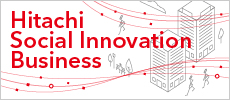Water & EnvironmentConnective Industries
1. Tama Waterworks Integrated Monitoring System for the Bureau of Waterworks, Tokyo Metropolitan Government
In the Tama district of Tokyo, there are 39 purification plants, 58 water supply plants, 102 water distribution plants, and 75 pumping stations, which distribute an average of about 1.15 million m3 of water every day within the district.
The Bureau of Waterworks of the Tokyo Metropolitan Government has issued a Master Plan for Construction of Tokyo Waterworks Facilities. This Master Plan proposes the centralized monitoring of the operations of the waterworks facilities that are scattered throughout the Tama district as part of a series of measures for strengthening water infrastructure in Tama.
Hitachi received an order for constructing integrated monitoring and operation equipment in 2019, and over a period of about five years, built an integrated monitoring system capable of the centralized monitoring of operations at all waterworks facilities in the Tama district.
This system features the use of a unified Human Machine Interface (HMI) to provide consistent HMI operability, in contrast to the previous system that differed from facility to facility. Redundant configurations are used for the communication devices that collect signals, improving the reliability and redundancy of the entire system.
In the future, through maintenance work to ensure stable system operations and by expanding functions as a result of renovating equipment at waterworks facilities, Hitachi will continue to support the stable supply of water in the Tama district.
2. Sewerage Blue Carbon Initiative Based on Nutrient Salt Supply Management
In sewerage systems, the application of advanced processing to remove nutrient salts has become widespread. This has improved water quality, especially in enclosed coastal seas. However, the decreased level of nutrients has become a new problem in recent years, resulting in greater need from the perspective of both ecosystems and fisheries for seas that are not only clean, but also rich in nutrients. Furthermore, the carbon absorbed and stored in the sea by marine ecosystems, including seaweed and seagrass (called “blue carbon”) has attracted attention as a measure to combat climate change.
In response, Hitachi developed the “Sewerage Blue Carbon Initiative,” whereappropriate nutrient salts are supplied from the sewerage system to achieve both seas rich in nutrients and decarbonization. To turn this concept into reality, Hitachi launched the “Nutrient Salt Supply Management Project for Promoting Blue Carbon” in December 2022 with the support and cooperation of sewerage and marine experts across industry, government, and academia. This project organizes and specifies technological and institutional issues and the required technological systems, and creates a road map for social implementation. The project also promotes educational activities, such as seminars and the issuance of white papers. In the future, Hitachi will accelerate initiatives aimed at social implementation through coordination with a wide range of related organizations, with the mission of contributing to the community by ensuring decarbonization and biodiversity, using fishery resources sustainably, and other activities.
[02]Sewerage Blue Carbon Initiative![[02]Sewerage Blue Carbon Initiative](/rev/archive/2025/01/13/image/fig_02.png) CPS: cyber physical system
CPS: cyber physical system
3. Remote Monitoring Control Equipment at Nakagawa Water Reclamation Center for the Bureau of Sewerage, Tokyo Metropolitan Government
The Nakagawa Water Reclamation Center of the Tokyo Metropolitan Government's Bureau of Sewerage conducts processing in most of Adachi Ward and some of Katsushika Ward. The Center processes wastewater and stormwater around Adachi Ward and prevents local flooding in an area that in the past experienced frequent flooding after heavy rain, and it also improves the quality of the river water (processing capacity: 225,000 m3 per day). Pumping stations at Higashikanamachi, Kumanoki, and Kahei collect local rainfall, pump up the water, and then release the water into the river. The Nakagawa Water Reclamation Center is connected to these pumping stations using the Bureau's dedicated fiber optic communications network to perform remote monitoring control. In this project, Hitachi renovated small-scale monitoring control devices at the pumping stations because they were deteriorating with age, while also renovating the pumping station monitoring control equipment at the Nakagawa Water Reclamation Center. The main features of this renovation work were as follows.
- Increased reliability by introducing redundancy to the controllers and communication lines located in each device.
- Ensured communication reliability and increased control response speeds for communications between the Nakagawa Water Reclamation Center and the pumping stations at Higashikanamachi, Kumanoki, and Kahei by delivering a Factory Automation (FA) data transmission device that uses the Bureau of Sewerage's proprietary common communication protocol, called the FA protocol.
(Operation starting date: April 2023)
4. Application of Biomass Plastic to Sewerage Equipment Parts
The sludge scraper is sewerage equipment with excellent recyclability because it uses a 300-class lightweight stainless steel chain with excellent corrosion and wear resistance as its main chain. However, resin originating in fossil fuels is used in some of its parts. Currently, this resin is not recycled but simply incinerated. To address this, Hitachi developed parts (shoe and filler block) that use biomass plastic.
The main raw material of biomass plastic is derived from plants, so the CO2 released during incineration is partially absorbed and offset as the plants grow. This means it generates less CO2 than resins originating in fossil fuels. Furthermore, test results show that characteristics such as the durability required of developed parts are equivalent to or better than the current parts derived from fossil fuels.
In July 2024, Hitachi received permission to use the Biomass Plastics Identification Indicator System mark of the Japan BioPlastics Association for the parts developed in this project. Hitachi is studying the future deployment of biomass plastics in more water treatment devices to further contribute to a carbon neutral society.
5. AI-based Stable Operation Support Technology for Sludge Dehydrators
In the field of industrial wastewater treatment, the water content in the dehydrated sludge discharged from the sludge dehydrator depends on the operation adjustment skill of the operator, because the sludge properties change significantly as the wastewater properties from production facilities change. However, the retirement of experienced operators has led to more operation adjustments being done by operators with inadequate skills. This has resulted in problems such as unstable operation due to inadequate adjustment, increased water content in the dehydrated sludge, and higher processing costs.
In response, Hitachi developed stable operation support technology for sludge dehydrators that leverages image analysis artificial intelligence (AI). Machine learning is used for image analysis AI. The learning model is based on floc images from coagulation tanks and dehydrated sludge images from screw-press dehydrators, in addition to data that labels the floc condition and water content of each image. When floc images and dehydrated sludge images are input, the image analysis AI estimates the floc condition and water content, and from the estimated results, also determines the setting guideline for the coagulant injection amount. This technology supplements the skills of operators to stabilize the performance of sludge dehydrators and reduce sludge processing costs.
[05]Stable Operation Support Technology for Sludge Dehydrators![[05]Stable Operation Support Technology for Sludge Dehydrators](/rev/archive/2025/01/13/image/fig_05.png) P: pump
P: pump
M: motor
6. Construction of Environmentally Friendly Stores with Energy Generation and Storage Equipment
MUFG Bank, Ltd. and Hitachi worked together to develop a new framework for environmentally friendly stores that combines elements such as mobile storage batteries (battery cubes), photovoltaic power generation, and electric vehicles. The first store applying this framework was introduced at the Nerima Branch of MUFG Bank in Tokyo, and a demonstration of its effectiveness has started.
In this demonstration, power generated during the day from the photovoltaic solar car pool located in the parking lot is stored in battery cubes made from reused batteries supplied by Hitachi. At night, the stored power is used to charge nine sales fleet electric vehicles (EVs). This maximizes the use of the renewable energy that was generated and increases the energy self-sufficiency of the store. Hitachi will also deliver an energy management system (EMS) to control the power charging and discharging that enables this series of operations.
In the future, Hitachi will consider reusing batteries removed from sales fleet EVs as battery cubes for even greater sustainable use of resources.
[06]Construction of Environmentally Friendly Stores with Energy Generation and Storage Equipment![[06]Construction of Environmentally Friendly Stores with Energy Generation and Storage Equipment](/rev/archive/2025/01/13/image/fig_06.png) *
(1) to (5) indicate the flow of electricity.
*
(1) to (5) indicate the flow of electricity.
7. Launch of Showroom at Nakanoshima Qross
Nakanoshima Qross* is an international hub for the future of medicine located in Osaka and operated by the Future Medicine Promotion Organization, which was established by the Osaka Prefectural Government, 21 private corporations, and other stakeholders. On August 1, 2024, Hitachi opened a showroom at Nakanoshima Qross with the objective of sparking co-creation with customers by solving various problems across the entire value chain of pharmaceutical and advanced therapy medicinal products (ATMP) through the latest Hitachi Group technologies.
The future goal of this showroom is to fulfill the role of three "hubs" that generate solutions for solving customer problems. It will do this by leveraging the Hitachi Group's IT, wide-ranging solutions, operational technology (OT), and diverse product lineup to promote co-creation with companies, partners, industry groups, public bodies, and other stakeholders who visit Nakanoshima Qross.
The showroom will raise productivity and increase the business value of the frontline workers of customers in the pharmaceutical and ATMP fields, and further contribute to the future medicine that will be provided to patients.

![[01]Diagram of Tama Waterworks Integrated Monitoring System](/rev/archive/2025/01/13/image/fig_01.png)
![[03]Nakagawa Water Reclamation Center Remote Monitoring Control Equipment](/rev/archive/2025/01/13/image/fig_03.png)
![[04]Sludge Scraper Exterior (top), Shoe (bottom left), Filler Block (bottom right)](/rev/archive/2025/01/13/image/fig_04.png)
![[07]Showroom Goal of Creating Three "Hubs"](/rev/archive/2025/01/13/image/fig_07.png)


